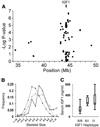A single IGF1 allele is a major determinant of small size in dogs
- PMID: 17412960
- PMCID: PMC2789551
- DOI: 10.1126/science.1137045
A single IGF1 allele is a major determinant of small size in dogs
Erratum in
- Science. 2007 Jun 1;316(5829):1284
Abstract
The domestic dog exhibits greater diversity in body size than any other terrestrial vertebrate. We used a strategy that exploits the breed structure of dogs to investigate the genetic basis of size. First, through a genome-wide scan, we identified a major quantitative trait locus (QTL) on chromosome 15 influencing size variation within a single breed. Second, we examined genetic variation in the 15-megabase interval surrounding the QTL in small and giant breeds and found marked evidence for a selective sweep spanning a single gene (IGF1), encoding insulin-like growth factor 1. A single IGF1 single-nucleotide polymorphism haplotype is common to all small breeds and nearly absent from giant breeds, suggesting that the same causal sequence variant is a major contributor to body size in all small dogs.
Figures




Similar articles
-
Derived variants at six genes explain nearly half of size reduction in dog breeds.Genome Res. 2013 Dec;23(12):1985-95. doi: 10.1101/gr.157339.113. Epub 2013 Sep 11. Genome Res. 2013. PMID: 24026177 Free PMC article.
-
Identification of genomic regions associated with phenotypic variation between dog breeds using selection mapping.PLoS Genet. 2011 Oct;7(10):e1002316. doi: 10.1371/journal.pgen.1002316. Epub 2011 Oct 13. PLoS Genet. 2011. PMID: 22022279 Free PMC article.
-
The IGF1 small dog haplotype is derived from Middle Eastern grey wolves.BMC Biol. 2010 Feb 24;8:16. doi: 10.1186/1741-7007-8-16. BMC Biol. 2010. PMID: 20181231 Free PMC article.
-
Evolutionary genomics of dog domestication.Mamm Genome. 2012 Feb;23(1-2):3-18. doi: 10.1007/s00335-011-9386-7. Epub 2012 Jan 22. Mamm Genome. 2012. PMID: 22270221 Review.
-
So many doggone traits: mapping genetics of multiple phenotypes in the domestic dog.Hum Mol Genet. 2012 Oct 15;21(R1):R52-7. doi: 10.1093/hmg/dds323. Epub 2012 Aug 9. Hum Mol Genet. 2012. PMID: 22878052 Free PMC article. Review.
Cited by
-
Investigating the influence of the SIRT6 gene and alternative splicing on canine longevity: an in-depth bioinformatics analysis and experimental confirmation via NGS-based targeted sequencing.Geroscience. 2024 Oct 22. doi: 10.1007/s11357-024-01386-8. Online ahead of print. Geroscience. 2024. PMID: 39433703
-
Identification of functional rare coding variants in IGF-1 gene in humans with exceptional longevity.bioRxiv [Preprint]. 2024 Oct 13:2024.10.11.617885. doi: 10.1101/2024.10.11.617885. bioRxiv. 2024. PMID: 39416202 Free PMC article. Preprint.
-
The resistance of domestic canine skin-derived fibroblasts to oxidative and non-oxidative chemical injury: implications of breed and body size.Geroscience. 2024 Sep 24. doi: 10.1007/s11357-024-01358-y. Online ahead of print. Geroscience. 2024. PMID: 39316259
-
Impact of ginger powder (Zingiber officinale) supplementation on the performance, biochemical parameters, antioxidant status, and rumen fermentation in Ossimi rams.Vet World. 2024 Jul;17(7):1619-1628. doi: 10.14202/vetworld.2024.1619-1628. Epub 2024 Jul 26. Vet World. 2024. PMID: 39185052 Free PMC article.
-
Signatures of selection in Angus and Hanwoo beef cattle using imputed whole genome sequence data.Front Genet. 2024 Aug 2;15:1368710. doi: 10.3389/fgene.2024.1368710. eCollection 2024. Front Genet. 2024. PMID: 39161420 Free PMC article.
Publication types
MeSH terms
Substances
Grants and funding
LinkOut - more resources
Full Text Sources
Other Literature Sources
Miscellaneous

